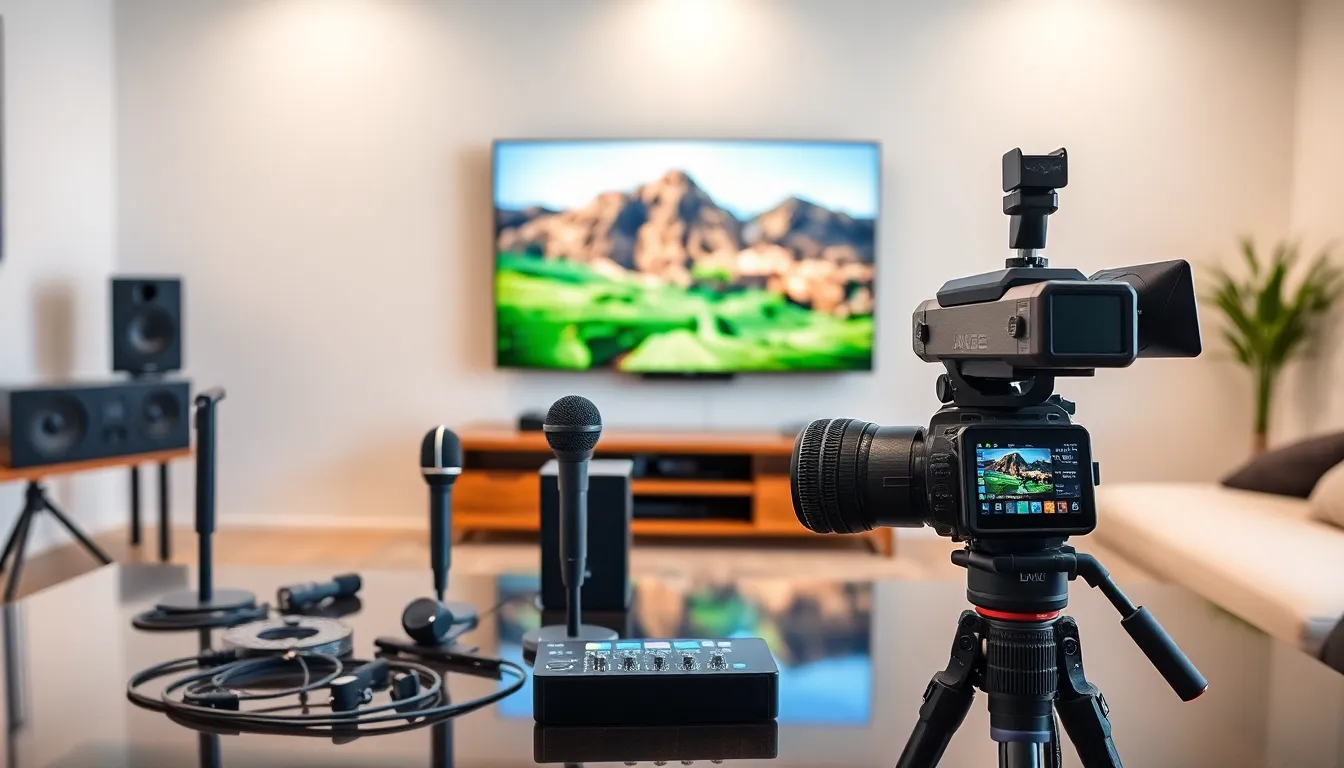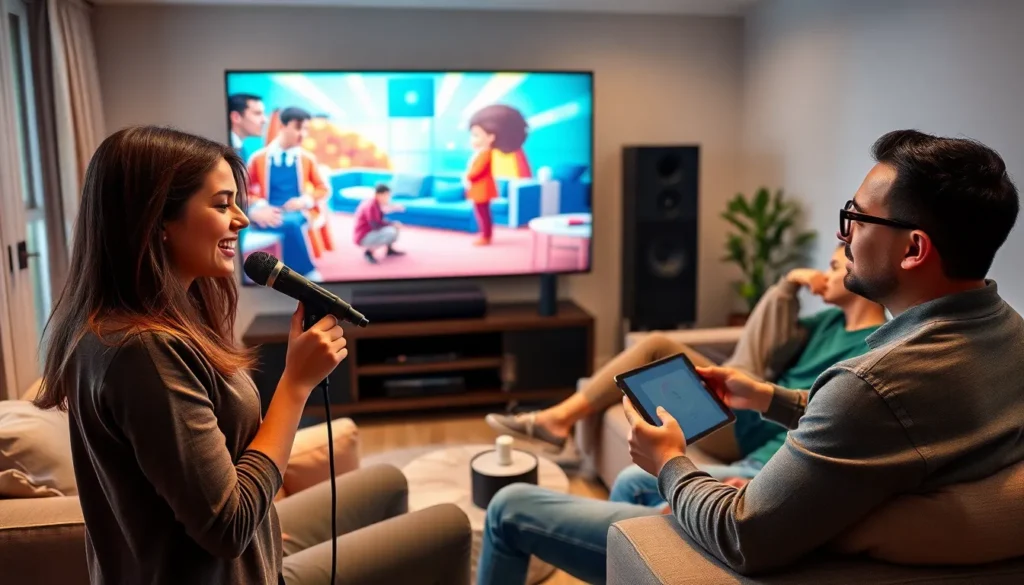Table of Contents
ToggleIn a world where silence is golden but the visuals are simply stunning, audio and video technology reign supreme. From streaming your favorite cat videos to producing blockbuster films, this tech transforms everyday moments into cinematic experiences. It’s like having a magic wand that turns mundane sounds and sights into a symphony for the senses.
Overview Of Audio/Video Technology
Audio and video technology plays a crucial role in shaping modern communication and entertainment. This technology encompasses tools and systems for capturing, processing, and displaying sound and images. Devices like cameras, microphones, and speakers serve as the backbone of audio and video experiences.
Streaming platforms revolutionized how people consume content. Users access thousands of movies, shows, and music tracks at their fingertips, available on-demand. Excellent examples include platforms like Netflix and Spotify, which consistently draw millions of subscribers globally.
Surround sound systems contribute to immersive experiences. By simulating a three-dimensional audio environment, users feel like they’re part of the action. High-definition video enhances visual quality, providing clarity and vibrancy that elevate viewing experiences.
Advancements in audio and video technologies include artificial intelligence and machine learning applications. These innovations improve content delivery and personalization, ensuring users receive customized recommendations based on their preferences. It’s evident that evolution in technology influences everything from social media interactions to professional video conferencing.
Accessibility improvements make audio and video technology more inclusive. Closed captioning, audio description, and sign language interpretation serve diverse audiences, breaking down communication barriers. Efforts to enhance user interfaces mean smoother experiences, appealing to all demographics.
Audio and video technology significantly impacts daily life, transforming how people connect, create, and consume content. With ongoing advancements, it’s clear that these technologies will continue to shape the future of communication and entertainment.
Key Components Of Audio/Video Systems

Audio and video systems comprise essential equipment that enhances communication and entertainment experiences. Their functionality contributes significantly to how users engage with content.
Audio Equipment
Microphones capture sound, playing a crucial role in audio clarity. Speakers reproduce audio, delivering rich sound experiences in home theaters or public venues. Mixing consoles enable sound engineers to blend various audio sources for balanced output. Amplifiers boost audio signals, ensuring playback at desired volumes. Headphones provide personal listening experiences, making them ideal for individual use. Sound interfaces connect microphones and instruments to computers, facilitating recording and processing. Together, these components create immersive audio environments that enrich users’ interactions.
Video Equipment
Cameras serve as the primary devices for capturing visual content. Video projectors display images on large screens, making them suitable for presentations or movie nights. Displays, such as televisions and monitors, showcase high-definition video for home viewing. Video switchers manage multiple video sources during live broadcasts or events. Editing software enables creators to fine-tune visuals for professional results. Streaming devices facilitate access to various online content, expanding viewing options. With these components, video systems transform how individuals consume and share visual media.
Emerging Trends In Audio/Video Technology
Audio and video technology continues to evolve rapidly, influencing various aspects of everyday life.
Streaming Services
Streaming services dominate the entertainment landscape. Platforms like Netflix, Hulu, and Disney+ provide vast libraries of content, allowing users immediate access to movies and shows. Content selection has expanded globally, with diverse offerings catering to various interests and cultures. Original programming enhances user engagement, fostering brand loyalty while drawing in subscribers. Additionally, integration of advanced algorithms personalizes viewing experiences, making recommendations more relevant. Live streaming events, from concerts to sports, also gain popularity, providing real-time interaction and engagement.
Home Automation
Home automation transforms how people interact with audio and video technology. Smart devices seamlessly integrate with home networks, allowing for remote control via smartphones or voice commands. Systems like Amazon Alexa and Google Assistant simplify management of various devices, including speakers and televisions. Multi-room audio solutions enhance convenience, allowing users to enjoy music throughout their homes. Enhanced security features, such as video doorbells and surveillance cameras, provide peace of mind while integrating audio-visual capabilities. This synergy improves both functionality and enjoyment, making entertainment more accessible and personalized.
Applications Of Audio/Video Technology
Audio and video technology plays a vital role in various sectors, enhancing interactions and experiences.
Entertainment Industry
Audio and video technology drives innovation in the entertainment industry. Streaming platforms like Netflix, Hulu, and Disney+ provide extensive libraries of films and television shows. These services leverage advanced algorithms for personalized viewing experiences, catering to individual preferences. Virtual reality (VR) and augmented reality (AR) technologies revolutionize how audiences engage with content. Concerts and live events increasingly incorporate high-quality audio systems and visual displays, elevating experiences for attendees. Interactive storytelling becomes possible through immersive narratives, enabling viewers to shape outcomes. Emerging trends create exciting opportunities for filmmakers, musicians, and content creators to connect with audiences.
Educational Purposes
Educational institutions benefit significantly from audio and video technology. Classrooms utilize digital content for interactive learning experiences, enhancing student engagement. Video conferencing platforms enable remote learning, allowing students to participate in classes from anywhere. Multimedia presentations combine audio, video, and visual aids to reinforce key concepts. Online courses frequently incorporate videos, making complex topics more digestible. Educational webinars and tutorials serve as valuable resources for skill development. Assistive technologies ensure inclusivity, helping individuals with disabilities access educational materials effectively. Overall, audio and video technology transforms learning environments, making education more accessible and effective.
Audio and video technology continues to redefine how individuals interact with content. Its ability to enhance everyday experiences makes it an integral part of modern life. As advancements like artificial intelligence and smart home integration emerge, the possibilities for creativity and communication expand further.
The ongoing evolution of streaming services and immersive audio-visual systems ensures that entertainment remains engaging and accessible. With a focus on inclusivity and personalization, these technologies are set to enrich lives even more. Embracing these innovations will undoubtedly lead to a future where audio and video experiences are more captivating than ever before.







